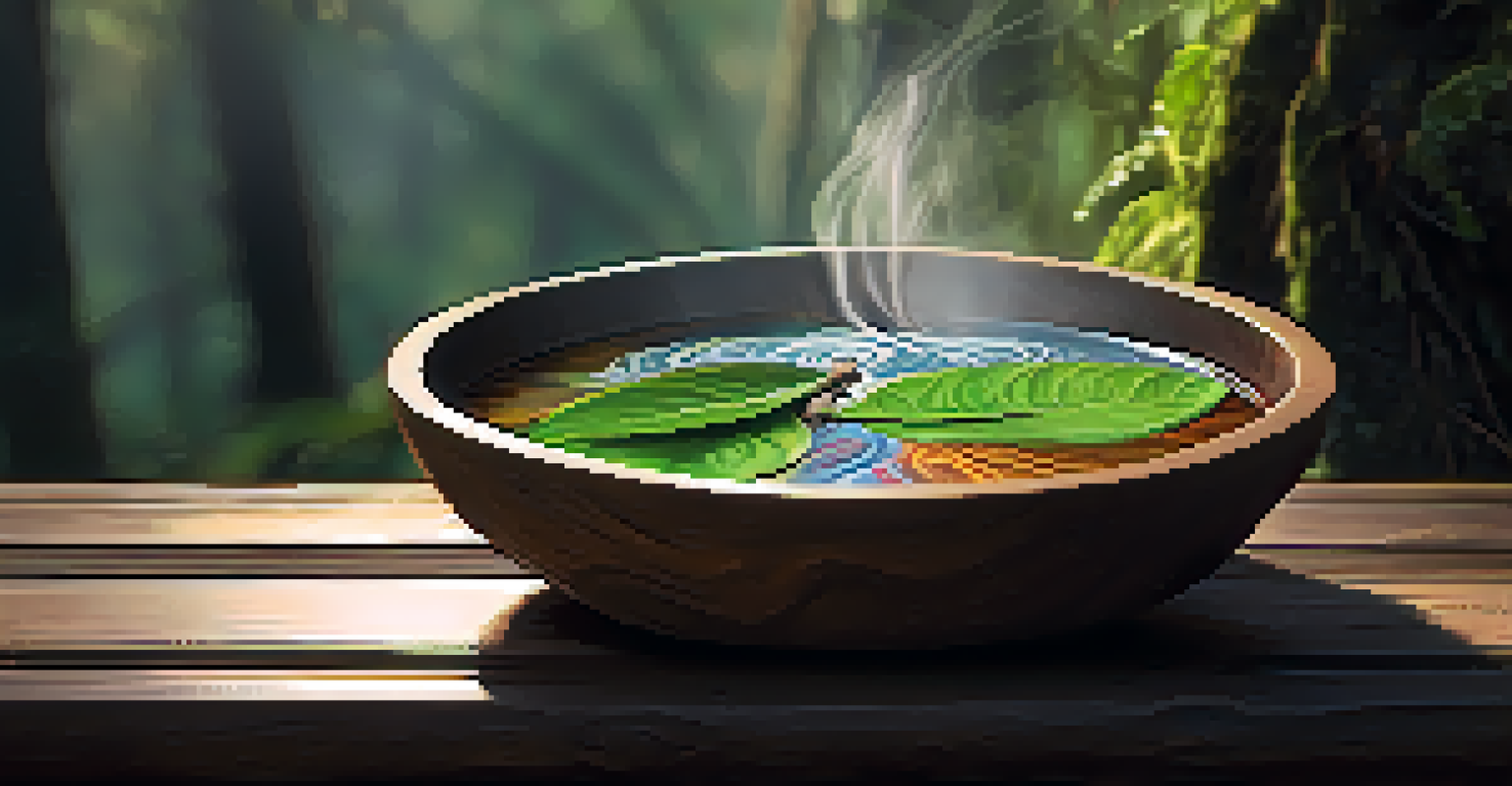Understanding Ayahuasca: Origins and Spiritual Healing Impact

What is Ayahuasca and Its Key Components?
Ayahuasca is a powerful brew made from the Banisteriopsis caapi vine and the Psychotria viridis leaf, both found in the Amazon rainforest. This combination creates a psychoactive experience due to the presence of DMT (dimethyltryptamine), a compound that can induce vivid visions and profound insights. Traditionally used in shamanic rituals, Ayahuasca has been revered for its potential to heal both physical and psychological ailments.
The experience of Ayahuasca can often lead to a confrontation with one's own emotions, allowing for profound personal transformations and healing.
The preparation of Ayahuasca is a sacred process, often conducted by experienced shamans who guide participants through their journeys. This ritualistic aspect adds a layer of spirituality and cultural significance, emphasizing the connection between nature and human experience. Many people seek out Ayahuasca ceremonies for various reasons, from seeking clarity to exploring deeper emotional issues.
Interestingly, the effects of Ayahuasca can vary widely among individuals. Some may experience intense purging, both physically and emotionally, while others may find peace and clarity. This unpredictability contributes to the brew's mystique and allure, making it a subject of fascination worldwide.
The Historical Roots of Ayahuasca Use
The use of Ayahuasca dates back thousands of years among indigenous tribes in the Amazon basin, where it played a crucial role in their spiritual and healing practices. These cultures viewed Ayahuasca as a bridge to the divine, allowing them to communicate with ancestors and spirit guides. This rich history is woven into the fabric of their daily lives, providing a sense of identity and community.

Archaeological findings suggest that the brew was used in rituals and ceremonies, highlighting its significance in pre-Columbian cultures. Over time, the knowledge of Ayahuasca's preparation and use was passed down through generations, ensuring that its powerful effects were not lost. Today, as interest in alternative healing grows, Ayahuasca's ancient practices are attracting attention from people around the world.
Ayahuasca: A Sacred Healing Brew
Ayahuasca is a powerful psychoactive brew used in traditional shamanic practices for spiritual healing and personal transformation.
As globalization increases, the traditional use of Ayahuasca is being adapted and commercialized, raising questions about authenticity and respect for its origins. Balancing modern interest with traditional practices is essential to preserving the cultural heritage surrounding Ayahuasca.
The Spiritual Healing Potential of Ayahuasca
Many individuals turn to Ayahuasca seeking spiritual healing, often reporting profound personal transformations. Participants frequently describe experiences of deep introspection, helping them confront unresolved traumas and emotional pain. This process can lead to a sense of clarity and purpose, as well as a renewed connection to oneself and the universe.
Ayahuasca serves as a bridge to the divine, allowing individuals to explore their inner worlds and connect deeply with their spirit.
The brew is believed to facilitate a unique state of consciousness, allowing users to explore their inner worlds in ways that conventional therapies may not. Some find that the insights gained during an Ayahuasca ceremony help them make significant life changes, whether it’s letting go of unhealthy relationships or pursuing long-held dreams. This transformative potential is a significant draw for many.
While Ayahuasca offers profound experiences, it’s essential to approach it with respect and caution. The journey can be intense, and participants are encouraged to prepare mentally and emotionally before engaging in a ceremony. Working with trained shamans in a safe environment is crucial for a positive experience.
Ayahuasca and Mental Health: A Growing Interest
Recent studies have begun to examine the effects of Ayahuasca on mental health, particularly its potential benefits for conditions like depression and anxiety. Some research suggests that the brew may help reset neural pathways, offering relief where traditional therapies have failed. This growing body of evidence has captured the attention of mental health professionals and patients alike.
Many participants have reported significant improvements in their mental well-being following Ayahuasca ceremonies. Stories of overcoming longstanding depression or anxiety resonate with those seeking alternative treatments. The communal aspect of the experience, combined with the deep introspective work, can foster a sense of belonging and support.
Cultural Roots and Modern Adaptation
The historical use of Ayahuasca by indigenous tribes highlights its spiritual significance, while modern interest raises questions about authenticity and respect.
However, it’s important to note that Ayahuasca is not a cure-all. Each individual's experience can vary widely, and the brew may not be suitable for everyone. Engaging in thorough research and consulting healthcare providers is essential before considering Ayahuasca as a therapeutic option.
Preparing for an Ayahuasca Experience
Preparation is key when considering an Ayahuasca ceremony. Participants are often encouraged to follow a specific diet and engage in mindfulness practices leading up to the experience. These preparations help to clear the mind and body, ensuring that individuals are in the best possible state to receive the brew's effects.
The diet typically includes avoiding alcohol, caffeine, and certain foods that may interfere with the brew's potency. Additionally, mental and emotional readiness is crucial; reflecting on personal intentions can guide the experience. This preparatory phase sets the tone for a more meaningful and impactful journey.
Moreover, it’s vital to choose a reputable shaman or retreat center that prioritizes safety and ethical practices. Researching and reading reviews can help ensure a supportive environment, allowing individuals to fully immerse themselves in the experience.
The Aftermath: Integration of the Ayahuasca Experience
After an Ayahuasca ceremony, participants often face the challenge of integrating their experiences into everyday life. The insights gained during the journey can be profound, but translating these revelations into actionable changes requires effort and reflection. Many find it beneficial to engage in integration circles or therapy sessions to help articulate and process their experiences.
Integration is a crucial aspect of the healing process, as it helps individuals make sense of their journeys and apply lessons learned. Sharing experiences with others who have undergone similar journeys can foster a sense of community and support. This shared understanding can be a powerful tool for personal growth.
Integration is Key Post-Ceremony
After an Ayahuasca experience, integrating insights into daily life is crucial for fostering lasting personal growth and change.
Ultimately, the goal of integration is to create lasting change, allowing the insights gained from Ayahuasca to influence daily life positively. By embracing the lessons learned, individuals can cultivate a deeper sense of awareness and connection to themselves and others.
Ayahuasca's Future in Modern Healing Practices
As interest in holistic health and alternative therapies continues to rise, Ayahuasca is gaining recognition as a potential tool for healing. The growing body of research supporting its benefits suggests that this ancient brew may have a place in modern therapeutic practices. This evolution presents opportunities for collaboration between traditional shamans and contemporary mental health professionals.
However, with this increased interest comes the responsibility to honor and respect the cultural heritage of Ayahuasca. Ethical considerations are paramount to ensure that the practices surrounding this sacred brew are preserved and not exploited. Promoting awareness and education about its origins can help prevent cultural appropriation and foster genuine understanding.

In the coming years, we may see Ayahuasca integrated into more structured therapeutic settings, bridging the gap between tradition and modernity. As we navigate this intersection, maintaining an open, respectful dialogue about its use will be essential for its future.